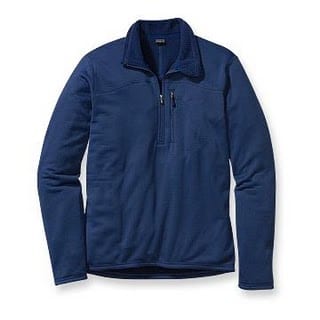A lot of tops and pullovers promise warmth without weight. And to be fair, most of them deliver on the promise, whether they are made from Polartec, company specific fabrics such as Patagonia’s own brand of fleece or even cheap no-name fleece. The difference between the various products is firstly cost: a no-name fleece will cost a quarter or even less than a branded fleece. So it may be tempting to go for the cheapest option. And to be honest I have a couple of cheap fleece pullovers in my draw that still go out on the mountains and also make useful warmers when I’m bumbling around at home or just going into town on a chilly day.
There is not a huge difference when you are simply looking at a mid-layer fleece in performance between an expensive one and a really cheap one. And the differences that do exist are not nearly as extreme as they would be between a good outer layer shell jacket made from Gore-Tex or eVent and a really cheap outer layer – there you clearly know what you are paying for.
The other big difference is in the longevity and performance of the basic fleece. In terms of longevity, a cheap fleece will start to look worn out after just a few cycles in the wash (so much so that I get upset with my wife when she washes my fleece tops) with little balls forming on the fleece. A good fleece such as the one I have mentioned above will go for years without showing much damage.
The second area is with regard to details of the fleece that can enhance its performance. I have a great Patagonia shoftshell jacket (unfortunately not made anymore or I would say more) that has an insulating layer of R1 fleece with a waffle structure. This helps it capture and hold more air pockets and adds to its ability to insulate without adding weight or bulk when packing. I also think it aids wicking as this jacket wicks brilliantly and although now stained and looking quite worn out is still a favourite that I regularly use for cycling to and from work when the weather turns cold.
All of this brings me to the point of talking about the R1 Patagonia pullover. The R1 pullover is made from the company’s own brand of “regulator” insulation fleece. As mentioned the R1 fleece performs really well and seems to last forever. It also provides great wicking and excellent warmth for a very light package. Like all mid-layer fleece tops it is completely useless in any sort of wind (unless you upgrade to a much less breathable windstopper type fleece) so it needs to go under a hard shell waterproof jacket or a soft shell jacket that keeps rain and water out. It will also stay relatively warm when wet, unlike cotton.
The detail on this top is also great. It has a deep zip so you can open up your whole chest when climbing hard to get rid of extra heat and moisture. It also has a mess pocket that is not that useful for storing much, but it does not interfere with the jackets fit, light weight or wicking properties. I find that these chest pockets are mainly useful for keeping a water bottle from freezing on really cold days out, but apart from that don’t care much for them.
The only downside of the Patagonia Pullover is that it is pricy (lists for about $125) and that if you are going to drop that kind of money then you may as well spend another $25 and go for the Patagonia R1 Hoody which is made from a very similar material but has a built in hood to keep your head and neck warm.
